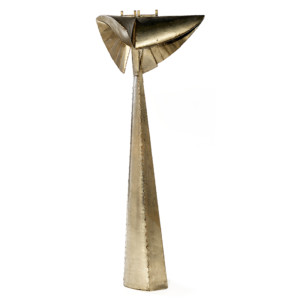(1923-2010)
Born in 1923 in Larisa, Greece, Philolaos studied at the Ecole des Beaux-Arts in Athens from 1944 to 1950. Among his classmates there were the sculptors Michael Tompros and Athanasios Apartis, who were also students of the famous French sculptor Bourntel. After serving his required time with the Greek military, Philolaos moved to Paris, France in 1950, and was granted a scholarship to study at the Ecole Nationale des Beaux-Arts. At around this time, he also began to work in the atelier of the sculptor Marcel.
From 1951-1967, Philolaos taught sculpture at the School of Clair, in the area of San Remi Sevrez, Paris. In 1956, Philolaos created his first public work – a bas-relief called “La Régence” for a project with the decorator Jacques Filacier. The 1960’s were a very productive time in his career, and he began collaborations with other architects and designers, who included his sculptures in their landscape commissions.
Philolaos’s father was a carpenter and his grandfather had been a brazier, so for the artist, it was quite natural to experiment with different materials, especially as he had enjoyed working in his father’s carpentry shop. His experiments there were the foundation of his art. In fact, he first began to work with lead, and then brass, and only adopted steel in 1960. From this point on, his material of choice was stainless steel. He added other materials, such as clay, wood, and marble to compliment the metal and provide added visual interest. He also created jewelry, in addition to furniture, sculptures and fountains.
Philolaos preferred to work on a flat surface, where he would stretch, fold, hammer, and solder sheets of metal together. He would “decorate” his pieces by scratching a shiny polished surface, and create added interest by juxtaposing a shiny surface with a dull one.
From 1963 until 1971, he worked on the Chateaux d’eau de Valence, a water tower sculpture in Valencia, under the architect André Gomis. The water reservoirs of Valence are considered to be among the greatest works of his career. Philolaos and Gomis had met several years earlier, in 1959, and their first collaboration lead to a famous fountain sculpture at the local school. In 1992 together with Francois Pierre, Philolaos created a park with his sculptures in the suburbs of Paris.
This work earned him worldwide recognition, and in 1981, he was awarded the Quartier de l’Horloge prize. This prize recognized the Valence water tower as one of the most important urban art works of the 1970s. During his career, Philolaos created important large scale public works throughout France. One of the most important is a huge double water tower in Valence, France, created between 1963 and 1971. It was awarded a n important prize as the best urban work of art of the 1970’s. It is over 200 feet tall, and has become an important reference for architectural sculpture.
Philolaos was honored in 1984, when he was awarded the Medal of Fine Arts from the Architecture Academy of France, and in March 2005, he was appointed an officer under L’Ordre des Arts et Lettres, and had an exhibition of his work at the Jardin du Palais Royal. Philolaos is today considered to be one of the greatest Greek artists of the 20th century.
Philolaos died in September 2010, and his ashes were scattered at his estate in San Remi Sevrez, where he had lived and worked. He considered this sculpture-house in the woods to be his finest piece of art.
He was married to French artist Marina, and his brother was the celebrated photographer Takis Tloupas. In 2009, for the first time in Greece, a large retrospective exhibition of Philolaos’s works was organized at the National Gallery in Athens.
Showing the single result


